CES 2015
 |
Today was my annual pilgrimage to Las Vegas to attend the Consumer Electronics Show. For reference, here are notes from my visits in CES 2014 and CES 2013. |
I admit defeat. In the past, when I’ve visited CES, I’ve prided myself that I could walk the entire show floor in a single day and get a pretty good appreciation of the offerings. This year, the expanded size of the show (The expo areas had the equivalent area of 35 football fields), meant that I was a little short of time. It looks like I’m going to have to dedicate two days to the show next year. There were certainly things I did not get to see this year.
Health
One of the biggest changes from last year is the complete explosion of the health/fitness category. It was big last year. This year it is immense. There are fitness bands, health trackers, and body function monitors. If you can name a bodily characteristic, there is a device that will monitor it. Even if you can’t name it (just what is a Pleth Variability Index?), there is still a device that will measure it, record it and shove it up into the cloud for you.

All this measurement/recording of bodily functions has made me invent a new term (which I’ll turn into a hashtag), it’s #TheInternalSelfie. There seems to be a fascination of taking internal measurements of the current state of our bodies (in just the same way that regular selfies capture images of our external selves).
There are wearables to measure heart rate, blood pressure, activity, oxygen levels, breathing rate, Insulin, distance travelled. … and on and on … There are even devices to analyze your breath.
 |
#TheInternalSelfie And don’t think you are safe after your exercise activity is over. There are devices to measure you in your sleep to record the quality and quantity of your slumber. These devices can also be programmed to wake you up from sleep close to your requested time in a ‘kind’ way (by understanding what your brain was doing and not interrupting you in a patch of high quality sleep). |
In the distant past, CES got into trouble with booths employing Playboy-like models to demonstrate their wares. This year, in the health section, just about every booth had some Lycra®-clad perfect specimen of a human being jogging, riding a bike, performing yoga, dancing or otherwise engaged in some healthy activity (a mixture of genders).

Sensors come in all shapes and forms. Many were wrist devices, but I saw a sensor Yoga Mat, and even a stick-on patch. The patch was interesting (applied on the back of your upper arm), in that it is intended to be worn continuously. The patch stays on 24 hours a day for 7 days, and records vital statistics every waking/sleeping/showering/exercising minute, for a total of 10,800 sample points over that week that you can analyze.
 |
 [ABOVE] Here’s someone on a treadmill playing a game of Solitaire. [LEFT] Week long monitoring patch. |
I even saw a pair of ‘smart socks’ and there were quite a few shoe in-sole sensors too. Connected health devices were not all wearable. Connected scales measured not just your weight, but also body fat and water content ready to be beamed to your monitoring app.
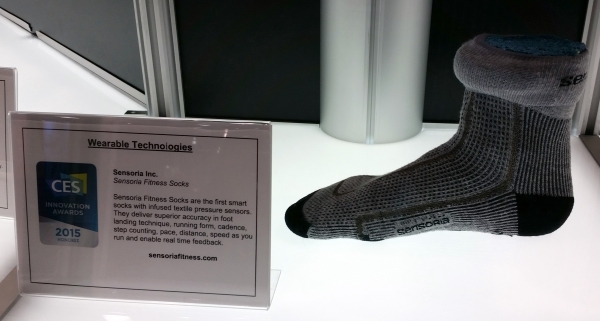 |
 [ABOVE] Smart yoga mat. [LEFT] Smart socks. |
It’s not just people, there were wearables for pets too*. Now you can monitor your pets’ activities remotely. Just how active has your cat been whilst you were at work? You can now be advised how far your dog has run, and can easily track him down if you are irresponsible enough to let him escape!
*And kids. There should not be an excuse for losing your kids anymore.
Telemedicine
This is starting to happen; and though specialized in nature, I think this will be a growing market. With the proliferation of sensing devices in the home, patients will be able to take their own vitals (along with historical trends of these), and transmit them to a Doctor, side by side with a video conference call. This should make diagnoses more efficient, as well as providing a whole wealth of data to help sharpen our skills at detecting health issues. Outside of the lack of human contact, I think this is a big win.
Smart Watches/Rings/Bracelets
 |
Wearables are not just for health monitoring. There were acres of Smart Watches, Smart Rings, Smart Bracelets, and Smart Pendants on display. Yes, some were activity monitors too, but many were smart devices (showing notification of emails, tweets, facebook posts, calendar postings, and yes, even the time!). I think this is a lucrative move for those involved who are successful. When you are moving into these markets, you are moving into fashion and branding. A typical Android tablet is valued at the cost of the sum of its parts; the cost of manufacture with some margin. It’s a commodity product (almost). A tablet is a tablet. A watch makes a fashion statement. It carries cache; there are brands, vogues and tastes (and trends). There is more than just margin on top of the cost of manufacture. If you need any more proof, check out these wearable offerings from Swarovski! |
The demo of one of the ring products (as a gesture input device), was promising [Shown below left]. Swirling a finger around is a prescribed manner could be useful for controlling things (such as adjusting volume of the radio in a car by winding your finger), or flipping pages in a virtual book with a finger movement. These uses I can see.
But, putting in a teeny-tiny display in a ring and using it as a device to receive tweets and status messages is a use case I don’t see a lot of value in [Right]. How many connected devices does a body need? Most people carry around their phone anyway (and typically these small devices need the phone nearby as they are tethered to them). Do you really need your phone, and a smart watch, and a smart ring, and a smart broach? Is it easier to look at a ring on your finger than glance on your wrist? And it’s yet another device that will need charging every day. Besides can you really get that much information onto a ring display other than a ‘something happened’?
 |  |
3D Printers
3D printers were everywhere. 3D printers are impressive to see, but they don’t necessarily demo well. They take a long time to make things, and (yes, I’m generalizing here), many of them use the same material stock to print with. Watching a device print an object is like watching paint dry. I’m not saying printers are commodity items, but it’s like comparing two Windows PCs. Ironically, what made one manufacturer stand out from the others was the quality of the demo materials they had pre-printed.
 |
 [LEFT} Skeleton, [CENTER} Hosue, [RIGHT] Printed dress |
 |
Booths that displayed cool printed models seemed to get better foot traffic. Here are a couple that caught my attention as I rushed by: A full size human skeleton. A set of musical instruments (drums, two guitars, and a keyboard skin) that were being played be musicians, and a 3D printed dress that looked (and felt) like plastic chain mail (they also had shoes but those looked very uncomfortable!) This 3D printed mansion model was pretty cool too.
One interesting innovation I saw was an (early stage) attempt to print 3D models in color without having to change source stock. In current generation devices, to print in multiple colors, you typically use multiple print heads; one for each of the colors you need. In this color printing implementation, a clear substrate is used into which CMYK dyes are added. The dyes need to be added in advance of the print head, so there is a phase-lag between the color being selected and its deposition in the model. Since the model is known, color changes can be planned ahead so that the correct color is passed to the head by the time the head is ready to print that color. The current implementation of the software, only allows color changes in the z-plane, and there is minimum distance between which colors can be successfully changed. What they are experimenting with is to see if it is possible to perform color changes in the same z-layer, by using un-seen, unnecessary, filler strokes in the model to flush out the plastic between color changes.
Side by side with the 3D printers, many manufacturers were showing 3D scanners with varying resolutions.
Another interesting innovation was the company Markforged, who can print models with embedded fibres like glass fibre, carbon fibre and Kevlar®
 |
Whilst this has been done before with chopped fibre, Markforged claim to be the first company to print and embed the stiff fibers as a continuous thread. This allows the direction of the thread to be controlled and, thus, the directional stiffness of the finished part. |
Handling the same demo models printed in different ways (with carbon fibre, glass fibre, and Nylon), it’s pretty easy to tell the relative stiffness’s of them.
Telepresence robots
Various people were demoing telepresence robots. These ranged from (literally) an iPad on a stick with some wheels at the bottom (wobbling as they moved), to some mature devices from people like Beam whose devices had recharging docking/garages and looked quite a bit more stable. All the devices had a strange ‘creepyness’ factor when they moved around and people talked from them.
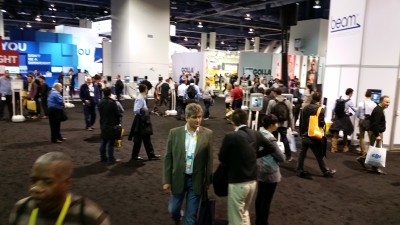 | 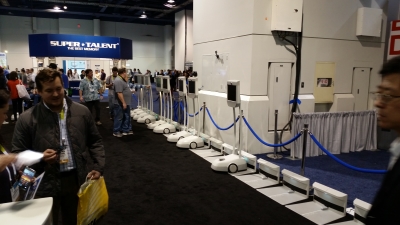 |
Internet of Things
Definitely a buzzword(s) of the show. Everything that could have an internet address is getting one (whether it needs one or not).
I love technology (I’m a self-confessed nerd), but I have to wonder if some of this is going a little too far. Putting a microcontroller in a toaster so that it can text me when my favourite bread product has been lightly browned might be of potential use to me that one time in five years that I put a piece of bread in it and forget about it (and assuming I had my phone with me to receive the alert), but otherwise, I can’t see the value. I’m certainly not going to junk my existing toaster just to upgrade. Being able to set the ‘brown-ness’ of my toast-to-be using an app on my iPad does not add any more value than a dial on the side of the toaster (especially since I have to walk to the toaster to put the bread in).
 |
It’s a similar thing with washer dryers. I think installing a microcontroller and humidity sensor into a dryer is a very smart thing to do (and a great energy saver, so that it can dry my clothes to just the correct level of moisture content, and no more). I might even like a delayed stop/start and some other smart option, but allowing me to control it from my iPad adds no value. What’s the point? Someone has to load clothes into and out of it, and having it text me when it's complete (probably the only marginally useful thing if I were in a hurry to get the clothes out), is not a compelling must-have for me. My current dryer buzzes and beeps when finished and that notification seems to work pretty well for me. |
The more complex a device is, the more the software probably will not work. Every couple of weeks, I’m delayed in being able to watch a movie as my BluRay player wants to install its latest software patch. The same with my game console. Even my TV sometimes requires a patch. Can you imagine the frustration of having to patch the dryer just so you can dry your clothes?
Similarly, what’s the advantage of an internet connected fridge? As long as it keeps my milk cold, do I really care about a graph of its temperature over the last 24 hours? If I want to know what’s inside it, I’ll look, and I’m certainly not going to scan things in and out of the fridge as I use them. If I want a browser in the kitchen with me, I’ll take my tablet thank you. You don’t need to build a browser into my fridge door (which will go obsolete within a year, never mind the patching mentioned above). Ask yourself; how often have you replaced your household fridge? 10 years ago? More? Would you really go back to using a 10 year old computer? If you buy a fridge with a browser in it, how clockwork is it going to look in 10 years time?
Smart Home
It seems like just about everything used in a house is now purchasable in a connected version. Light switches, door locks, thermostats, pet doors, ceiling fans, electrical outlets , sprinkler systems, security systems, weather stations, phones, home audio …
That’s fine as far as it goes, but as my good friend Ian keeps telling me (The owner of the World’s Smartest Home), that’s only the first part of the battle. Just being able to turn-on and off these things is fine, but how is the average consumer going to program and instruct these devices? The typical home owner never worked out how to adjust the flashing clock on their VCR, how on earth are they going to manage a plurality of devices and get them to behave in the coordinated way intended? Even with a natural language input, even if this is interpreted without error, it’s probably not the correct way to describe how the systems in a house should behave. The house itself has to be the interface.

I worry about standards too (or lack of them). I admit that I’m not expert in this field, but is there a standard for how sprinkler systems receive and broadcast data, and weather systems, and home security, and lights, and different manufacturers of distributed audio systems communicate?
It was bad enough having to set up learning remotes because the different TV/DVD/HiFi manufacturers could not agree on the way to change sources, or the protocol to increase volume (or even turn on and off). How’s it going to be once the whole house has to be controlled and is hybrid of a dozen manufacturers?
Can you imagine the nightmare of buying a house in a few years’ time and having to hire a consultant to help debug your house to stop the bedroom closet lights coming on every morning at 2am, or the sprinklers turning on every time your cat leaves the house when the temperature is below 40°F, the TV is on, and the kitchen lights off? I hope universal standards happen soon. I like standards.
And even with standards, how is the average person supposed to write complex conditional rules to describe what they want to happen. e.g. At 11:30 pm, turn off all lights on the ground floor, except rooms that you've detected people are in, unless it is a holiday, or Saturday, but if we've on vacation change it to random time. Oh, and if we're hosting a party, ignore that, and also ignore that if we're in the media room watching a movie in which case leave the kitchen and hallway light on until the movie is over. Please turn the thermostat down before we go to bed, unless the forecast tells us that it's going to be …
Drones R Us
 |
Lots of drones of various sizes and shapes were being demoed. You could immediately tell when you were walking up to booth where drones were being flown, not just from the characteristic whines of their blades, but also because of the floor to ceiling torpedo netting used to keep the attendees safe in the off chance that one of them got away or failed. I only witnessed one device depart from controlled flight (and it was the guy showing off, so pilot error and not hardware failure). The smallest drones seen were very cute: Small four bladed devices that would fit in the palm of your hand. These were more like toys (at this time), and controlled, typically, via tablets and smart phones. |
The largest devices seen (four and six bladed), were the size of small coffee tables, and had very impressive remotes with build in screens and lots of buttons.
 |  |
Some had contra-rotating dual blades, and looked pretty menacing. Others were available in very bright colors.
 |  |
TV
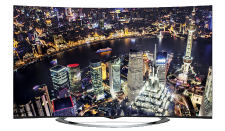 |
It would not be CES without big screen TV’s and this year did not disappoint. It’s interesting, however, how things have changed. For instance, 3D appears to be dead (as far a consumer TVs are concerned). I did not see a single 3D device on any of the major manufacturers booths. None. Not one. |
|
It’s no longer about size either. In shows past, there was competition as to who could make and show the biggest TV. These days, size is not important. All manufacturers offer panels in a variety of sizes up to the size you need (peoples’ living rooms aren’t that big; if you put too big a TV on the wall in your room, you can’t get far enough away from it to observe it properly). You select the size you need, not the biggest you can get. Everyone was offering curved screens too (some offering ones that transition between flat and curved with the touch of a button - see right). Everyone was showing 4k displays (UHD resolution, 4x that of current 1080p). |
 |
It's all about picture quality.
So, since it’s not about size, or curvature, or 3d, what is competition all about? What is the differentiator? That answer (and this is great news for the consumer), is picture quality. The better TVs, employing technology such as OLED, have much better dynamic ranges. The blacks are really black, the colors exceptionally bright. Manufactures are competing on image quality.
 |
I’ll admit it was under controlled conditions, but I saw a demo of a new OLED TV on the LG booth and have to say, it was probably the best TV image I have ever seen*. It was showing a 4k signal and the black background was so black in the darkened room it was almost sucking you in, and the image displayed was so bright and crisp, it’s as it stars were shining through the screen. It was very impressive. |
*Then I went to the Samsung booth and saw some of their offerings. They were very nice too. It would be hard to pick between them. Bottom line, a 4k signal and an OLED display, well adjusted, produces a magically stunning picture. It’s like looking through a window. You almost fall into the picture.
Yes, there were some large displays on show, but who cares if a display is 105” or 110”, these are devices I will probably never own (or if I do, I’ll need to knock a wall out in my house to watch from the next room). But I can appreciate the quality of a high dynamic range and hi resolution image.
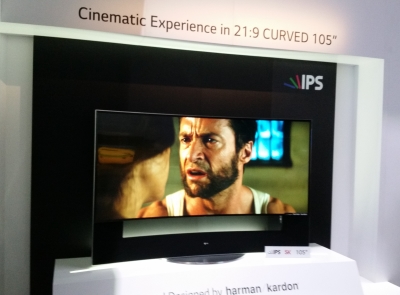 |  |
What about content?
 |
Various providers are starting to experiment with the output of 4k content to feed these new TVs appropriate signals (over HDMI 2.0). These include: Dish, DirectTV, Comcast and Netflix. 4k TV's will also up-scale 1080p (and coarser) signals through various interpolation mechanisms. Whilst these upscaled signals will not be as high a quality as a native 4k signal, the results can be very impressive, and significantly more pleasing to view than the original source. For a (very simple) example of how well this can work, check out my posting on Pixel Scalers (The scalers used in TV's are much more sophisticated). |
What about 8k?
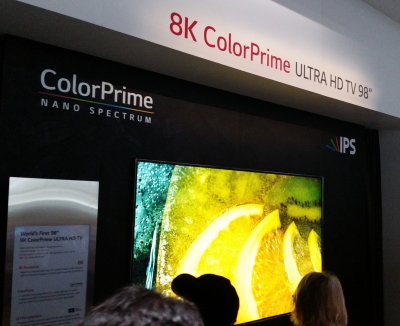 |
Various people were showing 8k displays, but to be honest they could have been, or they could not have been 8k. I could not tell the difference from 4k. Actually, to be honest, some (not all) of the 8k displays where showing images that, IMHO, appeared to be poorer quality than the close-by 4k displays. Maybe because the 8k displays were technology demonstrators (early prototypes with far from perfect manufacturing and tolerances). Sure, inevitably 8k will happen (I think I heard that the 2020 Olympics will be filmed in 8k), and I applaud (and understand), why the manufacturers want to show off their capabilities with this technology, but it’s still a few years away. |
It's not just for TV
Curved screens don't just have to be used for TV signals. I've you are lucky enough to own half a dozen of them, you can make a pretty impressive 'desktop' by tiling them:

Here the curves provide the advantage of being able to see all of the displays from where you sit. Since there is so much real-estate with a configuration like this, without the curve, the far extremes might not get noticed as easily.
Thin
Sony were showing some very thin TVs. It’s fun to see just how thin they are, but to be honest, even if they were 10x thicker than they are here, they would still be flat enough for me to mount on a wall and not know. I appreciate the engineering, but it’s vanity rather than practicality at this point.
 |  |
Viewed from this angle they look pretty thin! | From this angle, even thinner! |
Can you hear me?
TVs are so thin these days that they can’t really hold the speakers needed to provide the high fidelity sounded demanded by consumers. We’re seeing resurgence of ‘sound bars’ that lay underneath these TVs to provide rich sound across the spectrum.
Geek Stuff
 |
Here was a neat product I saw. A self-powered WiFi switch. It’s fine in your internet connected house for all devices to be controllable, but you might need to put switches for these things somewhere, and you don’t necessarily want to have to run wires to each. WiFi is an obvious way to solve the communication problem, but the switch device now needs power. You don’t want to run power lines out to them (if you did you might as well use these for communication), and you don’t want to make them battery driven (batteries need charging/replacing and could run out at an inconvenient time). The solution: make the switches self-powered. These switches required physical movement to operate. The action of pushing the switch moves a magnet past an inductive coil, and this movement generates enough current to power a WiFi broadcast of the command signal. |
 |
What do you get the man who has everything? Why a self-contained, microprocessor controlled microbrewery, that's what. In their own words: "The PicoBrew Zymatic® is the World's first internet-connected automatic all-grain beer brewing appliance for the home. It brews award-winning craft beer at the touch of a button using your own fresh ingredients, grain, hops water and more." |
 |
Out of your budget? How about a table with an inductive charging coil built in. No more messy cables. Come home, plonk your phone down on the table, and pick it up the next morning all ready to go! |
 |
Not ground breaking but this little robot turtle toy might be something I’ll buy my kids. The little bots can be programmed to follow colored lines and perform other tricks. They are pretty cheap (MSRP $49.95), and you can draw on paper using regular felt markers as well as getting them to scurry around tablets. ozobot.com |
Things I expected to see, but did not
I was expecting to see a lot more ‘selfie sticks’ in use on the show floor than I did (after all the hype in the media about everyone using them). There were certainly plenty of vendors selling them, but not many in use at the show. (And interestingly the sticks in use were operated by their owners like giraffe stalks to take pictures over the heads of the crowds of people at the devices in booths, and not to take pictures of themselves standing next to the devices!)
I did not see any Steam Box devices. I’m not saying there were none of these devices at the show, it’s just that I didn’t see them.
I didn’t see any handycam style video video camera recorders. The GoPro like devices have captured one section of the market, and the high-end market has been sponged up by the super high quality DSLR products with their wonderful (expensive) lenses and high resolution backs.
Similarly, the point-and-shoot camera market is just as decimated. Either the camera(s) in your smart phone/tablet are good enough (and they do seem to get better every cycle), or you step up to a fancy DSLR (as mentioned above). There seems to be no need for the middle ground (other than the niche rugged/waterproof market).
Interestingly, laptops seemed more visible this year. Last year, I don’t think I saw a single laptop at the show. This year, I saw quite a few. All of the ones I saw appeared to be light-weight, small, and ultra-portable.
Misc
 |
Augmented reality devices are starting to appear. These are subtly different from virtual reality devices (such as Oculus Rift). With augmented reality, you look through glasses into the real world and overlayed onto on your view is computer rendered meta data, images, and information (sort of like the shots in the through the eyes parts of The Terminator movies). This additional information enhances your view (like the head-up-displays used by fighter pilots). |
In Virtual reality devices, such as Oculus Rift, the entire image is computer generated.

I saw details of someone developing a game that used laser guns and they were shipping plans in the game that you can print out on a 3D printer to produce the controller that you’d use in the game. That’s kind of a neat idea. Can you imagine a time in the future where you’d buy a ‘board game’ entirely online, and it would come with the instructions for how to print the board pieces and layout the board (perhaps the board itself is would be displayed on a tablet?)
Deeper Fish finder. Some might call it cheating, but I’d simply call it leveraging technology. This little device from a company (in Latvia?), is a tiny echo sounder (and thermometer) you can attach to the end of a fishing line, and then lower it into the water (at also reports depth). Like the devices attached to fishing boats, it sends out sound pings which reflect off fish (if they are present), to help you identify their depth and school size. This devices tethers to your smart phone to send you pictures of the contours of the bed of the water and objects floating in it.
 |  |
 |
To help keep sportsmen safe, this helmet and mouth guard contain sensors that measure the g-forces the wearer has been exposed to. If someone who you love plays sports, I can see the value of purchasing one of these. |
 |
What do you use if you want to keep your acres of solar panels clean and free of dust? You might purchase the world’s first water free solar panel cleaner! It’s impressive to watch it clean one panel, but not as obvious how it moves from panel to panel. In a similar category were a collection of Roomba-like window cleaning robots. I’m sure they do a great job of scrubbing and cleaning the outsides of a window, as they hang on, but after cleaning one window they need taking off and placed on the next window (and filling and emptying). The manual part of moving a window cleaning robot is probably the biggest part of the equation. If you’re going to have to visit each window in turn to put the robot on (and take it off), why not simply wash the window yourself when you are there? Especially watching the pace about which they seem to crawl over the window when cleaning. I would imagine a competent window cleaner would be (at least) one order of magnitude faster, possibly two. What’s the point of climbing up a ladder, attaching one of these limpet devices on a window, hanging around whilst it spends a good five minutes cleaning the pane, then taking it off, moving your ladder to a new location and repeating the process? |
 |
goTenna is an interesting product to augment smartphones when outside of cell coverage. These devices are small FM transmitters that you tether to your phone and provide basic message services between them. Sold (as a minimum) in pairs, they allow point-point communication between devices using a built in FM transmitter. So, without need to provide people with additional communication equipment, using goTenna, existing phones can be used to communicate when cell coverage is not available. Still in early stages, it’s not hard to imagine how (regulations aside), that the software in these devices could be used as repeaters to make a mesh network and bridge between different services. |
 |
I used a low-cast eye tracker to build a lego duck. Useful for some things, and great as a research tool to find out what I’m looking at on web pages, but as an interface, I think I might still prefer touch and something tactile (You have to look at something and keep looking directly at it to select, and that’s not natural for me; people have peripheral vision, and with traditional tactile interfaces can select, click and swipe things that are not directly in their center of vision). |
High on the geek scale were some floating speakers. On these devices the top component ‘floated’ over the base (presumably through magnetism), and moved up and down (and I’m guessing it is this movement which caused the sound to be generated). I’m using the verb ‘guessing’ as, even though every one of these devices I saw at the show was floating successfully, I never heard any of them make a sound!

 |
Paper battery were showing high capacity capacitors (ultracaps), a plurality of which could be installed to fill in the interstitial spaces in your small electronic devices to augment the built in batteries to enhance time between charges. |
Autos
As I mentioned in the intro, I ran out of time visiting the show. I had to breeze past some sections. One of the sections I passed quickly by was the car section, so here are just a couple of highlights:
 |
Mercedes-Benz showed an auto-driving zero emissions (Hydrogen powered), technology demonstrator. If you see one in the wild and the grill is blue (like in the picture tp the left), then it means the car is in self-driving mode. If the grill is white, it means that a human is in control. |
 |
A Tesla model X was on display. This car can carry eight people 250 miles between charges and accelerate to 60 mph in about 5 seconds (though probably not with eight people inside!). It's all-wheel-drive too. |
 |
A Tesla too expensive or large for your needs? How about a battery powered scooter that has enough torque to burn rubber? |
 |
Other manufacturers were showing hydrogen powered vehicles too. Here is a picture of one from Toyota. |
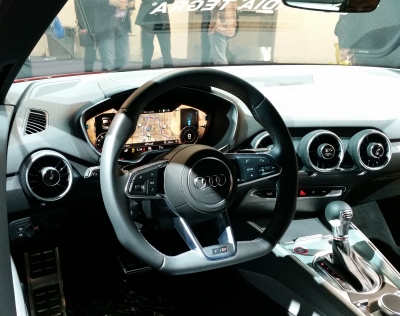 |
nNvidia were showing they are more than just a PC graphics card manufacturer. They had an impressive range of products showing electronic dash boards and instrument panels for vehicles. |
Things that I thought I would never see on the Expo Floor
Panasonic has a barber’s station on their booth! They had trained staff giving beard and moustache trims (demonstrating, I believe, the use of their rechargeable batteries in the groom tools used).
 |
 |
Not to be left out, the ladies had a make-up station 'Panasonic Beauty' which was an intelligent mirror (half silvered mirror with a TV screen behind). A hidden camera took video of the ‘victim’ sitting in front of the mirror and projected it from the rear of the glass to make it look like you were indeed looking in a mirror, but this image could be modified through the application of virtual make-up to test how it would look.
Best in Show
For the last few years, in my arbitrary and humble opinion, LG put out the best booth of the show. This year, whilst their booth was still good, I think that Samsung’s offering was my favorite. It wasn’t anything that LG did, or did not do, it’s just that this year their booth lacked a little wow factor that was present in previous years.
The Samsung booth was not complicated in design, but they seemed to offer a very high density of great products. Anyhow, well done to both Samsung and LG.
(Sony gets an honorable mention again this year for their open design – It looked very similar to their offering from last year).
WTF?
 |
OK, here's a device I just don't get. It's a voice commanded smart watch. You buy the watch, tether it to you smart phone, then issue Siri like commands to the watch (but with a more restricted set of vocabulary than the native voice command built into your Android/iOS device that you have next to the phone to make it work). Why not simply issue voice commands directly to your phone? Other 'useful' features include a remote shutter release for your smart phone, so you can point your smart phone at the object you wish to photograph, and then, rather than having to press the shutter button on your phone, you can scroll through the menus on the watch and it will allow you to take a picture by pressing a watch button. Why? If you are holding the phone, why not take the picture yourself? Ahah, you say, but what happens if you want to be in the picture yourself? Well, then hand your phone to someone else and ask them to take the picture! What if there is nobody there? Well, since there is nobody else there, how is the phone going to be held up? I don't you about you, but my phone does not have legs to allow it to stay stable veritcally. |
Saddest thing seen at the show?
 |
The saddest thing seen at the show was a device called ‘Belty’. It’s a smart belt containing a motor and, get this, it tightens and loosens dynamically with the size of your belly. Eat a lot, and it loosens for you automatically. OK, I’m being slightly uncharitable, it does other things too. It’s a smart belt and tracks your movements, and can be programmed to vibrate and remind you to get up and exercise (so that, maybe, it does not have to slacken up for you …) |
CES 2016
See you next year CES. Maybe for two days?
You can find a complete list of all the articles here. Click here to receive email alerts on new articles.
Click here to receive email alerts on new articles.

